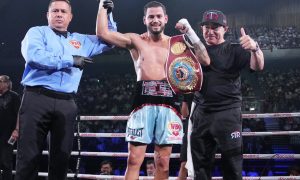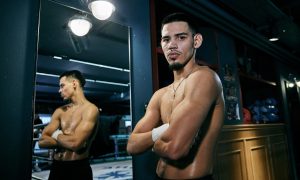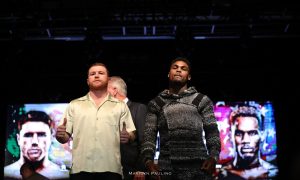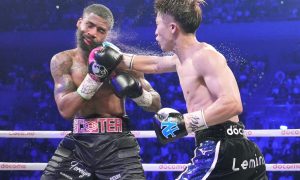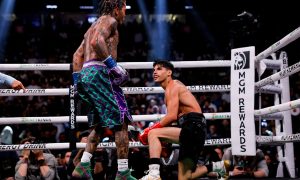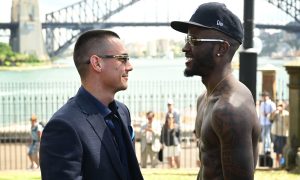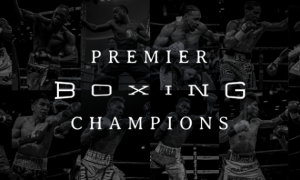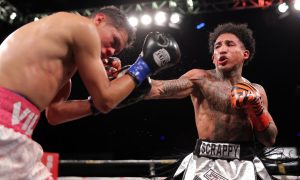Topic: Sonny Liston vs. Cassius Clay I
The flamboyant 22-year-old Cassius Clay–whom the world would come to know as Muhammad Ali after taking the adoptive name of his Muslim faith–claimed he was too fast, too young and too good for the champion Sonny Liston.
On February 25, 1964, Clay then went and backed it up by stopping Liston in Round 7 to win his first Heavyweight title, shocking the sports world in the process.
Why A Second Look
Ali’s hand speed, uncanny reflexes and the ability to dodge and make opponents miss with their punches were in full display that night. He called Liston slow. Perhaps if you were the fastest, most agile Heavyweight of all time, you could make that claim.
However, replays show Liston barely missing Ali with many of his shots. Ali was simply brilliant that night and just a couple of years away from reaching his physical peak. Liston’s pressure, persistent left jab, long right cross and powerful left hook was just off by a whisper against the supremely fast and slippery opponent in Ali.
Perspective
It is my opinion that no other fast handed and fleet-footed Heavyweight could have ducked and dodged, and used his legs to escape trouble like Ali did that night, including the likes of Larry Holmes, Jack Johnson, Roy Jones Jr., Gene Tunney, Jimmy Ellis, Michael Dokes and Greg Page.
Liston would have overwhelmed them all with the intensity, firepower and determination he showed for the first five rounds of Ali-Liston I. There is also no chance Liston would be considered a slow Heavyweight today. In spite of being only 6’1,” Liston had an extremely long reach of 84,” tremendous strength and punching power, was very accurate and methodical with his punches and possessed the stiffest jab in boxing history.
It took Liston less than one round to blast out the undersized, but extremely fast, Floyd Patterson in their two fights. He would have given any other Heavyweight all they could handle. He is inaccurately labeled a powerful but slow, plodding Heavyweight even until this day.
Topic: Donald Curry’s Boxing Career
For a brief period, between 1984 to 1986, Donald Curry was considered by many the best pound-for-pound fighter in the world–a mantle he proudly carried after the sudden retirement of his boyhood hero Sugar Ray Leonard the first time.
This was during a period when all-time greats like Marvin Hagler, Thomas Hearns and Michael Spinks were still near their primes, and Larry Holmes and Aaron Pryor were still the reigning champions in their respective weight classes. Blessed with tremendous hand speed, exceptional punching power and accuracy, an airtight defense and ring intelligence, the “Lone-star Cobra” was destined to be an all-time great fighter. He appeared unbeatable and the perfect boxer–but then it all unraveled for him.
Why A Second Look
Curry also had an outstanding amateur career, finishing with a record of 400 wins to only 4 losses. He was the 1980 World Cup Welterweight champion and beat out future world Junior Middleweight champion, Davey Moore at the US Olympic trials to earn a spot on the US national team but did not compete in the Moscow Olympics in 1980 due to the US boycott.
As a professional, Curry dominated the Welterweight division in the early to mid 80’s that was rich in talent, beating the likes of WBC champion Milton McCrory to unify the titles, Marlon Starling (twice), Colin Jones, Nino LaRocca, Elio Diaz and Roger Stafford.
Then shockingly, a visibly weakened Curry–drained from drastically losing 21 pounds in two days in order to make weight in defense of his undisputed Welterweight title–lost to the unheralded Lloyd Honeyghan in a shocking upset. He then seemed to lose focus, discipline and desire after that.
It was punctuated by a chilling knockout loss at the hands of the great Mike McCallum for the Junior Middleweight crown in a fight he was winning. His career was met with mixed results after this, losing to the likes of Michael Nunn, Rene Jacquot and Terry Norris.
Perspective
Most boxing writers, commentators and fans may feel his time at the top was very brief and that is why he has not been voted into the International Boxing Hall of Fame (IBHOF). If he does not eventually make it in, Curry may become the only boxer considered the top fighter pound-for-pound boxer in the sport in his heyday not to get voted in.
Recent boxers that have carried the mythical moniker as the best pound-for-pound boxer in the world like Floyd Mayweather Jr., Manny Pacquiao, Roy Jones Jr. and Roman Gonzalez are all certainly future first ballot hall-of-famers. And Donald Curry is undeserving of such a dubious distinction.
Exciting, unyielding, but limited boxing champions like Ray Mancini, Johnny Tapia, Arturo Gatti and Bobby Chacon are all in the hall. This year’s inductee, Riddick Bowe was immensely talented and defeated Evander Holyfield for the undisputed Heavyweight championship of the world but he too had a rather short shelf life as did Curry. The Cobra deserves to be in the hall too and my guess is that he will eventually get voted in.
Topic: Muhammad Ali’s Sparring Partners
Muhammad Ali is widely considered the greatest Heavyweight champion of all time because he fought and beat the best during the division’s golden era. But he also worked with some of the most gifted sparring partners in boxing history to help prepare him for those epic battles.
Consider who his chief sparring partners were in chronological order: Jimmy Ellis, Larry Holmes, Michael Dokes and Tim Witherspoon. He also regularly sparred Greg Page, Tony Tubbs and Tony Tucker.
Why A Second Look
One of Ali’s sparring partners would go on to become a boxing legend himself in Holmes, but all of them had tremendous talent and became Heavyweight champions as well. And Ali would spend countless hours going to war with them in sparring sessions during different phases of his illustrious career, right up until the end.
Leave it to the “Greatest of All Times” to have a succession of the best sparring partners of any boxer in history. It is a mind-blowing fact.
Perspective
When Ali was diagnosed with Parkinson’s disease, doctors and the general public widely believed it was attributed to boxing-related brain injuries. During the second half of Ali’s career, after his return from exile for draft evasion, he was notorious for getting out-of-shape between fights and began a disturbing trend of allowing his sparring partners to wail away at his body and head during their sparring sessions.
No point belaboring my point here because some might consider it merely speculative and even controversial, but I feel it is quite obvious. As much as the accumulative punishment Ali sustained at the hands of Joe Frazier, Ken Norton (both in three grueling encounters each), George Foreman, Earnie Shavers, Larry Holmes and others took its physical toll on the boxing great, I firmly believe he sustained more damage from his heated, regular sparring sessions with some of the division’s best young talent whose job it was to beat him into fighting shape.
In the end, it just robbed him of his mobility, ability to speak and ultimately something more precious.
Header photo by Getty Images






